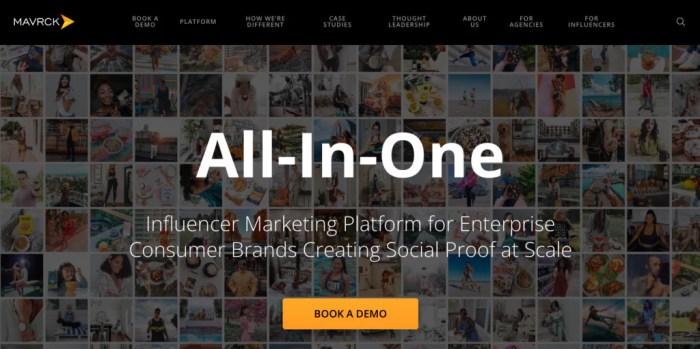Influencer marketing tools set the stage for this enthralling narrative, offering readers a glimpse into a story that is rich in detail and brimming with originality from the outset. In today’s digital marketing landscape, the significance of these tools cannot be overstated; they provide essential support for brands aiming to leverage the power of influencers effectively. As influencer marketing has evolved, so too have the tools that facilitate it, adapting to meet the dynamic needs of marketers and consumers alike.
Key features such as analytics, outreach capabilities, and management functionalities play a crucial role in selecting the right influencer marketing tool, helping businesses optimize their strategies and achieve their marketing goals. With various types of tools available, understanding their functionalities and impact is vital for brands looking to stay ahead in a competitive marketplace.
Overview of Influencer Marketing Tools
Influencer marketing tools have become an essential component of modern marketing strategies, enabling brands to connect with their target audiences through influential figures. These tools streamline the process of identifying, managing, and measuring influencer partnerships, which can significantly enhance a brand’s reach and engagement.
The evolution of influencer marketing has been remarkable, transitioning from traditional celebrity endorsements to a more diverse landscape involving micro and nano influencers. As this landscape continues to change, the role of influencer marketing tools has become increasingly crucial, facilitating seamless collaboration and data analysis. When selecting these tools, businesses should look for key features such as influencer discovery, campaign management, analytics, and reporting capabilities.
Types of Influencer Marketing Tools

Influencer marketing tools can be classified into several categories based on their functionalities. Each category serves a distinct purpose, which helps brands optimize their influencer marketing efforts.
- Influencer Discovery Tools: These tools allow brands to search for and identify relevant influencers based on criteria such as audience demographics, engagement rates, and niche. Examples include AspireIQ and Traackr.
- Campaign Management Tools: These tools assist in planning, executing, and managing influencer campaigns, ensuring effective communication and collaboration. Examples include HypeAuditor and Upfluence.
- Analytics and Reporting Tools: These tools track campaign performance and provide insights into metrics such as reach, engagement, and ROI. Popular options are Meltwater and Sprout Social.
| Tool Name | Category | Key Features |
|---|---|---|
| AspireIQ | Influencer Discovery | Search filters, audience insights, campaign management |
| HypeAuditor | Campaign Management | Follower analysis, campaign tracking, reporting |
| Meltwater | Analytics and Reporting | Social listening, performance metrics, customizable reports |
Selecting the Right Influencer Marketing Tool

Before choosing an influencer marketing tool, businesses should assess their specific needs and objectives. A checklist can help streamline this process and ensure that the chosen tool aligns with marketing strategies.
Factors influencing the selection process include budget constraints, target audience characteristics, and overall marketing goals. For instance, a brand targeting Gen Z may prioritize tools that focus on platforms like TikTok and Instagram, while a B2B company may seek tools catering to LinkedIn influencers.
Case studies of successful brands illustrate the effectiveness of selecting the right tools. For example, a leading fashion brand utilized Upfluence to connect with micro-influencers, resulting in a 30% increase in engagement and a significant boost in sales.
Utilizing Influencer Marketing Tools Effectively
To maximize ROI from influencer marketing tools, brands should implement strategic approaches that enhance their campaigns. Best practices include integrating the tools into existing marketing strategies, enabling cohesive messaging across channels, and fostering strong relationships with influencers.
A step-by-step guide for setting up and using a specific influencer marketing tool, such as AspireIQ, involves:
1. Creating a detailed campaign brief outlining goals and objectives.
2. Utilizing the discovery feature to identify suitable influencers.
3. Sending personalized outreach messages to selected influencers.
4. Monitoring campaign progress through the tool’s analytics dashboard.
5. Analyzing performance data post-campaign to refine future strategies.
Measuring Success with Influencer Marketing Tools
Measuring the success of influencer marketing campaigns involves tracking various metrics that reflect performance and effectiveness. Key performance indicators (KPIs) to evaluate include engagement rates, conversion rates, and overall reach.
Methods for tracking these metrics through influencer marketing tools may involve setting up UTM parameters for links shared by influencers, utilizing built-in analytics dashboards, and conducting regular performance reviews.
| KPI | Description | Assessment Method |
|---|---|---|
| Engagement Rate | Measures audience interaction with content | Analytics dashboard; formulas for likes, shares, comments |
| Conversion Rate | Tracks the percentage of audience completing desired actions | UTM tracking links; sales data analysis |
| Reach | Indicates the total number of unique users exposed to content | Influencer tool metrics; social media insights |
Future Trends in Influencer Marketing Tools
Emerging technologies are poised to shape the future of influencer marketing tools significantly. Innovations in artificial intelligence and data analytics are transforming how brands strategize their influencer campaigns, enabling more precise targeting and personalized content delivery.
As AI continues to evolve, it offers sophisticated algorithms that can analyze vast amounts of data to identify trends and predict audience behavior. Additionally, brands must navigate potential challenges, such as increased competition and regulatory scrutiny, while remaining aware of the opportunities for enhanced engagement and authenticity in influencer marketing.
With the rise of new platforms and changing consumer preferences, staying informed about these trends is crucial for brands looking to maintain a competitive edge in their influencer marketing endeavors.
End of Discussion

In summary, the journey through influencer marketing tools reveals their transformative potential in modern marketing strategies. By effectively utilizing these tools, brands can not only enhance their outreach but also measure their success through actionable insights. As technology continues to advance and new trends emerge, staying informed and adaptable will empower businesses to navigate the evolving landscape of influencer marketing with confidence.
